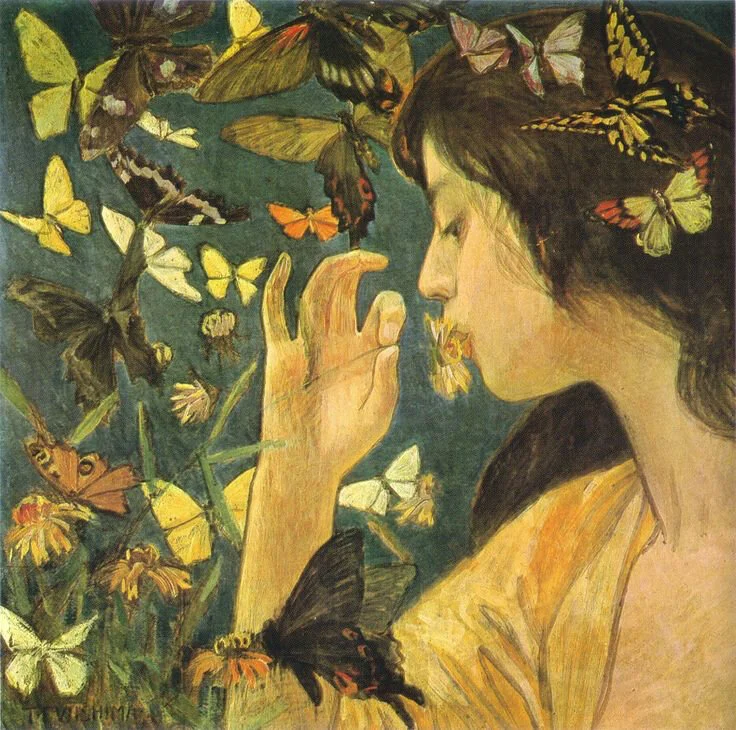10 Types of Healing Plants for Mental Health and Emotional Wellbeing
In this article I will be exploring many of the traditional ways that people have worked with plants to help heal from metal and emotional complaints. In reality any herb can be an “herb for mental health” . If one is struggling from chronic bronchitis, then lung herbs that help a person recover would impact their mood and overall wellbeing as well. Herbs that heal external wounds or improve kidney function or work on any level to heal physical maladies will spill over into improving mental health as well. But in this context I am focusing on herbal categories that traditionally are deeply helpful for emotional complaints such as anxiety, insomnia, stress and sadness.
1 Nourish
2 Tonic
3 Bitters
4 Aromatics
5 Environmental Herbalism
6 Energetic medicine
7 Nervines
8 Nerve Tonics
9 Strong Plants
10 Psychedelics
1 Herbs that nourish
These are herbs that are nutrient rich, containing a wide variety of minerals and vitamins. These herbs are especially useful for those who appear undernourished and lacking vitality. These herbs are closest to being food and are generally very gentle with few adverse side effects associated with them. These herbs are also often helpful for those who eat a standard American diet that lacks a great deal of nutrient dense foods. One of the ways that nourishing herbs can also help is to offer prebiotic starches that act as food for healthy bacteria. Healthy bacterial flora in the gut are now known to not only improve gut health but to improve mood and wellbeing as well. One of the ways they help is to stimulate the vagus nerve to encourage a parasympathetic “rest and digest” response. Some classic inulin prebiotic rich herbs include burodck, dandelion and elecampane root. Fermented foods are also a time honored way to improve the flora in the gut microbiota.
Some examples include:
Nettles, oatstraw, red clover, seaweeds, hawthorn berries, elderberries, douglas fir tips, moringa, burdock, dandelion, cacao.
Main methods of administrations: Broth, teas, syrups, elixirs, ferments such as kim chi, sauerkraut and kombucha.
2 Tonic Herbs
These are herbs that have long been used for their ability to strengthen, build resiliency and stamina. Sometimes called adaptogens, this category of herbs includes many plants and mushrooms that have been used for thousands of years to build and fortify the constitution so that one can adapt to stressors better. In India this category of herbs is known as rasayanas or longevity promoting tonics and includes holy basil, ashwaghanda and gotu kola. In Chinese medicine these are often herbs that “tonify qi, blood and yin” and some include ginseng, astragalus and rehmannia.
Examples:
Stimulating: Rhodiola, Asian ginseng, Holy basil, eleuthero, devil’s club
Nourishing: American Ginseng, ashwaghanda, rehmannia, codonopsis, astragalus, solomon’s seal, reishi, red belted conk
Main methods of administration: Broths, teas, tincture, syrups and double extractions
3 Bitters
Though we don’t tend to think of bitter herbs as particularly associated with mental health, they are often some of the most important herbs for working with people who are struggling with mood issues. This is because bitters work at a number of levels to help a person. At the very start of the journey, tasting a bitter herb actually directly activates vagal nerve receptors in the mouth and digestive system to bring greater calmness and improve gut motility. Bitter herbs also improve gastric secretion of digestive enzymes so if the liver and gut is sluggish, bitter herbs improve digestion and elimination of waste metabolites. If we are not digesting properly then we won’t absorb nutrients from food fully and the gut lining can breakdown and lead to inflammatory compound leaching into the bloodstream. Improved liver and gut functioning also decreases skin ailments such as eczema and psoriasis.
So in terms of mental health- bitter herbs are often good for those who have sluggish digestion with chronic backup of waste that comes out as skin ailments and also as low level malaise and depression. In chinese medicine the term for this diagnosis is “liver qi stagnation” which is treated by a combination of bitter, tonic and aromatic herbs.
Some examples include:
dandelion, burdock, Oregon grape, yellow dock, angelica, gentian, fennel
Methods of administration: decoctions, tincture, in meals
4 Aromatics
These are herbs that have a strong aromatic profile and are some of the plants we notice most immediately in our environment. Think of walking through a garden of roses, or through a forest filled with aromatic pines and spruces. Aromatic terpenes evaporate as an aerosol in the air and our nose passively draws these compounds into the body and lead to a quick shift in mood. From burning smudge such as cedar or sage, to working with essential oils and hydrosols, to making incense, aromatic plants are some of the most easy to incorporate for many people from young to old, infirm to healthy. Though many people are allergic to synthetic scents in perfume and air fresheners, most people enjoy natural scents. In terms of mental health, aromatic plants do a number of things: they stimulate, sedate, improve circulation, improve lymph drainage, gladden the heart, help with expectoration in the lungs and diaphoresis.
Some examples of aromatic plants for mental health include:
lavender, rosemary, douglas fir, cedar, sage, oregano, sagebrush and black cottonowood.
Main methods of administration: Infused massage oils, salves, creams, bath salts, incense, essential oils, teas, tinctures
5 Environmental Herbalism
We can also call this category nature based healing. This includes the wide range of ways that humans can heal from spending time and doing activities in nature. Some ways include forest bathing to qi gong to gardening to spending time with plants in forests and fields to backpacking in the wilderness. Increasingly humans spend most of their time indoors and have lost contact with the natural pulses and rhythms of the seasons and the ebba and flow of the plant world. Prior to ten thousand years, humans were all subsistence hunters and gatherers. Only a few hundred years ago we shifted away from agrarian societies to industrial factory based societies. These changes have made us more sedentary and likely to spend most time indoors. Nature deficit disorder is a term coined for the increasing lack of connection to the natural world and all its benefits. In terms of mental health, studies have shown that environmental herbalism helps reduce stress, improve mood and wellbeing, reduce anxiety, depression and improves the quality of sleep.
Examples: Gardening, hiking, forest bathing, qi gong, backpacking
6 Energetic Medicine
One of the most powerful ways of working with herbs is to connect to them energetically- meaning tuning into their subtle and invisible properties to access healing. Traditionally most cultures have a sense of particular “power plants” in their environment that they return to again and again for their “teachings” and wisdom. From cedar to tobacco to grapes to mugwort to palo santo to cacao these plants not only impart direct physical healing, they also teach lessons about how to walk the world in a good way.
In the Western tradition in modern times, common ways of working energetically with plants includes sitting with a plant or tree to taking preparations such as flower essences and “drop dosages” of plants. Tuning into plants subtle vibrations has been a time honored and gentle way to help people heal from emotional concerns. Perhaps the most famous modern way of accessing energetic plant healing is via flower essences. Promoted by Edward Bach in the 30’s, he saw that each flower and plant carried messages and teachings that could help us to move through deeply challenging emotional knots and wounds. More recent teachers such as Matthew Wood promotes using very tiny (1-5 drops) of plants (known as drop or spirit dosing) to effect healing for both physical and emotional maladies.
In my view, working with the plants that grow locally is the most profound way of working with plants energetically. The more we are in deep relationship with the local plants, the more that we can pass that depth of relationship and healing onto friends, allies and clients. Each plant has its own story and teaching. For example, black cottonwood helps with releasing stored up tension and sorrow while also calming and building resiliency. Douglas Fir helps bring us greater strength, joy and openness to life. Some other examples of plants to work with energetically:
Mugwort, elder, cedar, black cottonwood, wild rose and wild ginger
7 Nervines
These are plants that have a marked effect on the nervous system. Though they can also refer to stimulating nervines like coffee and mate, in general they tend to mean plants that have a marked relaxant effect own the body. I also use the term anxiolytics, antispasmodics and hypnotics for more specific ways of describing the herbs. Nervines range from very gentle (linden) to very strong (kava). In general the gentle nervines are appropriate for most people while one must be more cautious about the use of stronger nervines- especially in terms of med contraindication.
Gentle nervines: Chamomile, lemon balm, motherwort, hawthorn, passionflower, linden, bleeding-heart, lavender
Strong nervines: Kava, valerian, hops, cramp bark
Method of administration: Gentle nervines are commonly found in teas while stronger nervines are more commonly offered as tinctures.
8 Nerve Tonics
These are herbs and fungi that have a marked strengthening quality to the nervous system, building resilience and a sense of inner peace and contentedness. They range from herbs that have a marked antidepressant and anxiolytic quality (Saint Johns Wort, Albizia, hawthorn) to nervous system tonics such as skullcap, milky oats and reishi.
Examples: St. John’s Wort, Mimosa (Albizia), Hawthorn, skullcap, milky oats, reishi.
Method of administration: Teas, tinctures, double extractions and syrups
9 Strong Plants
This is a large category of plants that have a strong and marked effect upon the nervous sysetm- ranging from strong stimulation (coffee) to strong sedation (Indica and CBD rich varietals of cannabis). They are useful for immediate effect and are often used as part of a larger role of social cohesion. For example, think of folks getting together to drink beer made with wheat and hops. Or think of gatherings to consume cannabis. in other cultures, khat or betel nut play the role of stimulant within a social context. Our beloved coffee houses are places where we not only stimulate our nervous system but also make connections and build community, key to healthy communities. Of course strong plants can cause a variety of side effects and social ills such as addiction as well so these are tricky plants to work with.
Examples: cannabis, kanna, alcoholic beverages, khat, kratom
Method of administration: Smoking, as edibles, alcoholic beverages, in tincture
10 Psychedelics
Cultures throughout the world commonly use plants and fungi that elect extraordinary changes in perception and consciousness. Traditionally these plants and fungi have been strongly revered as transformative agents for divination, self-exploration and healing. We continue to make these substances illegal to popular consumption but there is increasing evidence that they can be truly helpful and healing for many people. Recent research from NYU and John’s Hopskins since 2000 have shown efficacy for treating people with concerns ushc a anxiety, OCD traits, addiction and end of life grief.
Examples: peyote, psychedlic mushrooms, ayahuasca, san pedro,
Method of administration: Tea, tincture, directly consumed
Conclusion
Though any medicinal plant can be likely considered an “herb for mental health”, as the health of our body impacts the health of our mind; but there are some plants and fungi that are specifically known for helping to improve mood and emotional wellbeing. This is a brief primer on ten categories of plants that are specifically helpful in this area.
This article written by Jon Keyes, Licensed Professional Counselor and herbalist. For more articles like this, please go to www.Hearthsidehealing.com. You can also find me at the Facebook group Herbs for Mental Health.














